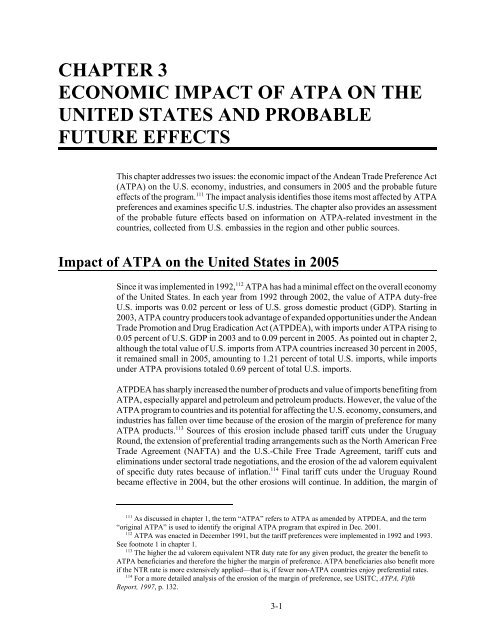The Impact of the Andean Trade Preference Act Twelfth ... - USITC
The Impact of the Andean Trade Preference Act Twelfth ... - USITC
The Impact of the Andean Trade Preference Act Twelfth ... - USITC
- No tags were found...
Create successful ePaper yourself
Turn your PDF publications into a flip-book with our unique Google optimized e-Paper software.
CHAPTER 3ECONOMIC IMPACT OF ATPA ON THEUNITED STATES AND PROBABLEFUTURE EFFECTSThis chapter addresses two issues: <strong>the</strong> economic impact <strong>of</strong> <strong>the</strong> <strong>Andean</strong> <strong>Trade</strong> <strong>Preference</strong> <strong>Act</strong>(ATPA) on <strong>the</strong> U.S. economy, industries, and consumers in 2005 and <strong>the</strong> probable futureeffects <strong>of</strong> <strong>the</strong> program. 111 <strong>The</strong> impact analysis identifies those items most affected by ATPApreferences and examines specific U.S. industries. <strong>The</strong> chapter also provides an assessment<strong>of</strong> <strong>the</strong> probable future effects based on information on ATPA-related investment in <strong>the</strong>countries, collected from U.S. embassies in <strong>the</strong> region and o<strong>the</strong>r public sources.<strong>Impact</strong> <strong>of</strong> ATPA on <strong>the</strong> United States in 2005Since it was implemented in 1992, 112 ATPA has had a minimal effect on <strong>the</strong> overall economy<strong>of</strong> <strong>the</strong> United States. In each year from 1992 through 2002, <strong>the</strong> value <strong>of</strong> ATPA duty-freeU.S. imports was 0.02 percent or less <strong>of</strong> U.S. gross domestic product (GDP). Starting in2003, ATPA country producers took advantage <strong>of</strong> expanded opportunities under <strong>the</strong> <strong>Andean</strong><strong>Trade</strong> Promotion and Drug Eradication <strong>Act</strong> (ATPDEA), with imports under ATPA rising to0.05 percent <strong>of</strong> U.S. GDP in 2003 and to 0.09 percent in 2005. As pointed out in chapter 2,although <strong>the</strong> total value <strong>of</strong> U.S. imports from ATPA countries increased 30 percent in 2005,it remained small in 2005, amounting to 1.21 percent <strong>of</strong> total U.S. imports, while importsunder ATPA provisions totaled 0.69 percent <strong>of</strong> total U.S. imports.ATPDEA has sharply increased <strong>the</strong> number <strong>of</strong> products and value <strong>of</strong> imports benefiting fromATPA, especially apparel and petroleum and petroleum products. However, <strong>the</strong> value <strong>of</strong> <strong>the</strong>ATPA program to countries and its potential for affecting <strong>the</strong> U.S. economy, consumers, andindustries has fallen over time because <strong>of</strong> <strong>the</strong> erosion <strong>of</strong> <strong>the</strong> margin <strong>of</strong> preference for manyATPA products. 113 Sources <strong>of</strong> this erosion include phased tariff cuts under <strong>the</strong> UruguayRound, <strong>the</strong> extension <strong>of</strong> preferential trading arrangements such as <strong>the</strong> North American Free<strong>Trade</strong> Agreement (NAFTA) and <strong>the</strong> U.S.-Chile Free <strong>Trade</strong> Agreement, tariff cuts andeliminations under sectoral trade negotiations, and <strong>the</strong> erosion <strong>of</strong> <strong>the</strong> ad valorem equivalent<strong>of</strong> specific duty rates because <strong>of</strong> inflation. 114 Final tariff cuts under <strong>the</strong> Uruguay Roundbecame effective in 2004, but <strong>the</strong> o<strong>the</strong>r erosions will continue. In addition, <strong>the</strong> margin <strong>of</strong>111 As discussed in chapter 1, <strong>the</strong> term “ATPA” refers to ATPA as amended by ATPDEA, and <strong>the</strong> term“original ATPA” is used to identify <strong>the</strong> original ATPA program that expired in Dec. 2001.112ATPA was enacted in December 1991, but <strong>the</strong> tariff preferences were implemented in 1992 and 1993.See footnote 1 in chapter 1.113 <strong>The</strong> higher <strong>the</strong> ad valorem equivalent NTR duty rate for any given product, <strong>the</strong> greater <strong>the</strong> benefit toATPA beneficiaries and <strong>the</strong>refore <strong>the</strong> higher <strong>the</strong> margin <strong>of</strong> preference. ATPA beneficiaries also benefit moreif <strong>the</strong> NTR rate is more extensively applied—that is, if fewer non-ATPA countries enjoy preferential rates.114For a more detailed analysis <strong>of</strong> <strong>the</strong> erosion <strong>of</strong> <strong>the</strong> margin <strong>of</strong> preference, see <strong>USITC</strong>, ATPA, FifthReport, 1997, p. 132.3-1
















